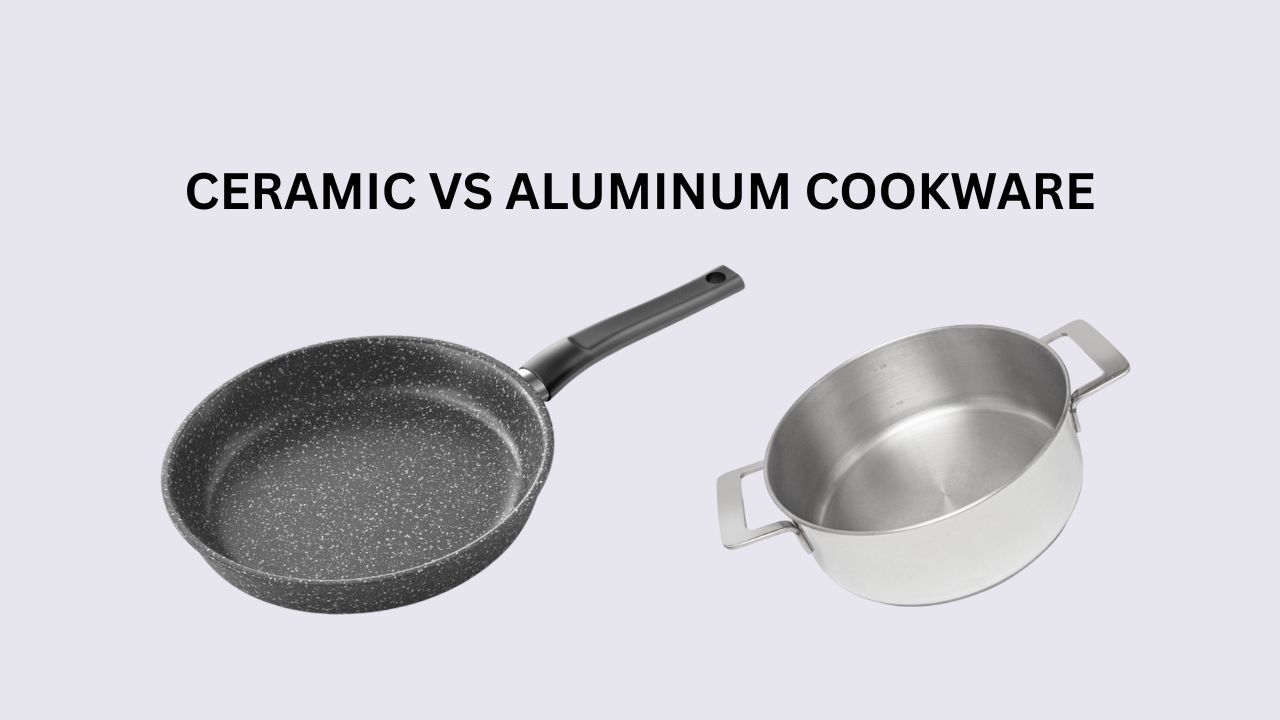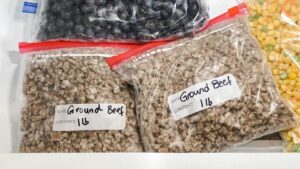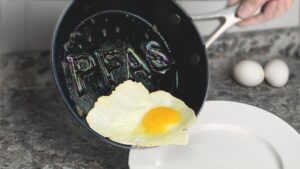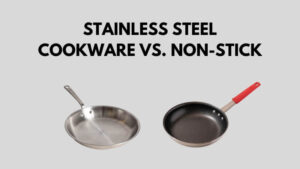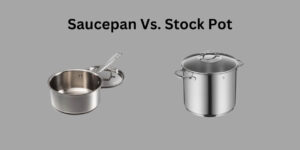The cookware you use can significantly impact the quality of your meals. It can also make or break your cooking experience. Ceramic and aluminum are two widely used materials in kitchens worldwide, each offering distinct benefits.
Ceramic is often favored for being non-stick, while aluminum is lauded for its heat conductivity. But which one is the better fit for your cooking needs? Let’s explore the key ceramic vs aluminum cookware differences to find your perfect match in the kitchen.
What are Ceramic Cookware and Aluminum Cookware?
What is ceramic cookware?
While the name “ceramic cookware” suggests that it is made entirely of ceramic, most modern versions feature a metal core, typically aluminum, coated with a ceramic layer. This layer is created using natural minerals baked into a slick surface.

Read more: Granite Cookware vs Ceramic Cookware
What is aluminum cookware?
Aluminum cookware is made primarily from aluminum, a highly conductive metal. There are two common types: raw and anodized. Raw aluminum cookware is untreated. It conducts heat exceptionally well. However, it can react with acidic or alkaline foods. Anodizing makes it non-reactive. Anodized aluminum cookware is more durable and often comes with a non-stick coating for easier cooking and cleaning.

Key Differences Between Ceramic vs Aluminum Cookware
According to Google Trends, ceramic cookware takes the lead in terms of popularity between 2020 and 2025, but aluminum cookware has its strengths, too. Let’s take a closer look at how the two differ.
Heat conductivity and retention
When it comes to heat conductivity, aluminum outperforms ceramic by quite a bit. Aluminum heats quickly and evenly, making it ideal for high-heat tasks like frying or searing. This efficiency allows for precise temperature control, which is particularly important for delicate recipes.
Ceramic cookware also distributes heat evenly, but it takes longer to heat up and performs best at medium to low temperatures. This is because its coating can degrade at very high heat. To compensate, however, ceramic cookware is better at retaining heat.
Non-stick performance
One of the standout features of ceramic cookware is its natural non-stick surface. It ensures food that does not get stuck and lets you cook without excessive oil. However, this coating can wear down over time, especially with frequent use or exposure to high heat.
Nowadays, aluminum cookware often comes with a non-stick layer, which can range in quality depending on the brand. While both options provide convenience, ceramic cookware requires more careful handling.

Durability
Durability is an important factor when choosing cookware. Ceramic cookware is more prone to chipping, scratching, and damage over time. It requires gentle cleaning and the use of non-metal utensils to avoid damaging the coating.
Aluminum cookware is generally more durable, especially in anodized varieties. Raw aluminum can dent more easily, but its anodized counterpart is able to last for years.
Cost
For budget-conscious cooks, aluminum cookware is often the more affordable choice. Anodized aluminum cookware is slightly more expensive but still reasonably priced considering its qualities.
Ceramic cookware, while typically more expensive, offers the added benefits of eco-friendliness and elegance. For those willing to invest in cookware that aligns with a sustainable or stylish lifestyle, ceramic cookware can be worth the higher price tag.
Compatibility
Gas stoves
Ceramic-coated cookware works on gas stoves. However, you should avoid exposing the ceramic coating to excessively high heat for long periods, as this can degrade the non-stick layer. It is best to stick to a low or medium flame. Also, make sure you do not preheat an empty ceramic pot or pan.
Aluminum is an excellent conductor of heat, making it highly compatible with gas stoves. However, raw aluminum pans might warp or discolor over time due to direct flame exposure. Anodized or coated aluminum is more durable and better suited for gas cooking.
Electric stoves
Ceramic pans and pots are a good choice for electric stoves. Their flat bottoms make even contact with the stove’s surface, ensuring steady heating. However, you should avoid dragging the cookware across the burner, as ceramic coatings can chip or scratch.
Similarly, aluminum works efficiently on electric stoves, especially when the cookware has a flat base for maximum heat transfer. As with ceramic, be careful not to slide aluminum pans and pots to prevent scratches on both the cookware and the stovetop.

Induction stoves
Most ceramic cookware is not compatible with induction stoves unless it has a magnetic metal base. Check the manufacturer’s specifications to ensure compatibility. If the pan or pot is not induction-ready, it will not generate heat on the cooktop. Aluminum by itself does not work on induction stoves because it is non-magnetic. But some are designed with a magnetic base to be induction-compatible.
Maintenance
Ceramic cookware
One of the pros and cons of ceramic cookware is that while it offers excellent heat distribution, the coating can be prone to scratches if not handled carefully. When considering how to cook with ceramic cookware, always use low to medium heat to prevent the coating from deteriorating. Avoid using it under a broiler or on an open flame.
For cleaning, allow ceramic pots and pans to cool completely before washing them to avoid thermal shock, which can lead to cracks or chips. Use soapy water and a soft sponge. Do not use abrasive scrubbers that can scratch the non-stick surface.
If the stains are stubborn, soak your cookware before scrubbing. Also, use silicone or wooden utensils when cooking to avoid damaging the coating. Proper storage is equally important. Stack ceramic cookware with soft barriers like paper towels to prevent scratches.

Aluminum cookware
Aluminum cookware is a versatile option for many kitchens. However, the latter of the pros and cons of aluminum cookware include its tendency to react with acidic or alkaline foods if not anodized. With raw aluminum, avoid storing acidic foods because this can corrode the material.
When cooking with aluminum cookware, ensure even heat distribution by using low to medium heat settings. Prolonged exposure to high temperatures can cause warping. When cleaning aluminum cookware, handwashing is best, even if the pan or pot is labeled as dishwasher-safe. Avoid abrasive cleaning tools that could scratch the surface. To prevent damage during storage, place protective layers between stacked aluminum pans.
Experience When Cooking Mac and Cheese on Both Cookware
When I make mac and cheese, I personally prefer using ceramic cookware. It heats up slowly, but once it’s there, it keeps everything nice and warm, which is perfect for that creamy, smooth texture I love. It does take a little longer to cook, but the results are totally worth it.

On days when I’m in a rush, I’ll grab aluminum cookware. It heats up super fast, cutting down on cooking time, but I’ve noticed it doesn’t hold heat as well as ceramic. The edges can cook a bit faster, so I have to keep an eye on it. If I’m after a quick fix, aluminum’s great. But if I’m aiming for that rich, slow-cooked comfort food vibe, ceramic wins every time. Both work, just depends on how much time you’ve got.

Which one will you choose?
When comparing ceramic vs aluminum cookware, each has its strengths depending on your priorities. Aluminum cookware stands out for its excellent heat conductivity, durability, and affordability. If you are focused on practical performance and a material that is less prone to damage over time, aluminum is the better option for your kitchen.
Ceramic cookware, while slightly more expensive, appeals to those who value eco-friendliness and a naturally non-stick surface. It is a good choice if you are willing to invest in proper maintenance and handle it with care to ensure it lasts longer. Remember to replace ceramic cookware once its coating begins to wear.

